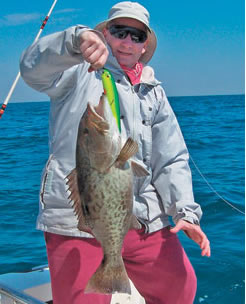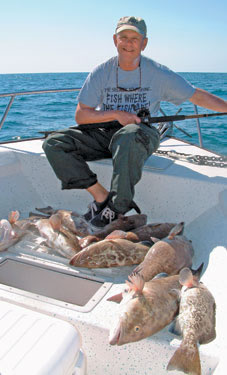April 03, 2012
By Tommy Thompson
This might be your season to learn the shallow-water grouper game.

Capt. Tommy Hines, displaying a chunky gag, says there's more grouper habitat within nine miles of shore than many anglers realize. |
I decided many years ago that there must be a secret society into which offshore grouper anglers are initiated at an early age.
I must have missed the secret handshake, and the ceremony when young, virgin fishermen were rubbed with pogy oil, sun-baked threadfin herring and sweat, then beaten for days in 4-foot seas.
I've always preferred my grouper fishing low-key and close to shore. The days are shorter, the ride is smoother, there's less pain at the gas pump—and the fish are just as tasty.
Federal and state regulations for red grouper are continually are changing, so the best advice we can offer is, check with authorities and sources like
www.floridasportsman.com before you head beyond 9 miles from shore. On the other hand, you might not want to leave state waters. Why? Because there are plenty of fish available close to shore. You just have to know where and how to look for them.
Inshore grouper fishing requires more precision than the offshore game.
“Patience is essential,” said Tommy Hines, veteran grouper angler and past president of the Gainesville Offshore Fishing Club.
In areas like the waters off Cedar Key, Suwannee and Steinhatchee, many anglers motor over good bottom on the way to what they think will be more productive spots offshore. “Most of them don't even have their bottom machines running,” said Hines, “and that's a sure way to miss finding new grouper spots!”

The bigger the lip, the deeper the dive. High-strength, small diamerter braid helps, too. |
There are hundreds of numbers for wrecks, reefs and “grouper holes” available to all of us. However, finding a spot of our own is what we all dream of, and it can still be done on Florida's Gulf Coast. As waters cool, grouper begin to move closer to shore, seeking bait and the comfort of warmer, shallower water. This doesn't necessarily mean the flats, but could easily mean deep cuts through the shallows. Rockpiles, like those scattered between Hudson and Crystal River, typically hold fish, as do channels such as the Tampa Bay ship channels and the Cross-Florida Barge Canal at Yankeetown.
Start at home with a chart and some aerial photos. You won't likely find rockpiles or wrecks using them, but you might find spots where they might be. Look for deep cuts in shallows that are near deeper channels, or for shoals that might have newer wrecks close by. Deep, dead-end gouges several miles out can also hold grouper over rocks that have accumulated there over time. I once found the remnants of a shrimp boat in 10 feet of water with a few legal gags hanging around. It wasn't much more than the shadow of the original hull on the bottom and had only been there a few years, but the grouper found it attractive. Next, take your homework or research out on the boat and poke around. “Poke” is a good term, as you'll want to take a slow and methodical approach to searching for new grouper spots.

The arrival of jacket weather usually signals an inshore push of keeper-class gags. |
Be sure you fully understand your depthfinder. Color units seem to help in distinguishing live bottom, baitfish and even grouper. Select the proper gain and sonar frequency (200 kHz has an edge in target definition in shallow water; 50kHz is what most guys use for deep offshore waters). If you can't pick up bottom detail at speed, you may need to reposition your transducer. Cavitation can dog a transom-mount unit, so you might look at a thru-hull or in-hull mounting. It's not expensive or terribly complicated to adjust all this; discuss options with your local electronics dealer.
You may have the best luck finding a grouper spot by running a slow-speed search pattern at a selected depth. In the 30-foot depths off Manatee, Sarasota and Pinellas Counties and in the 60-foot depths off the Panhandle you're likely to cruise over nice areas of live bottom—and legal gags. Captain Terry Dowden of Carrabelle has lots of “last stop” numbers well within state waters that are always worth fishing and Capt. Bob Bryant has some spots just on the limit of federal waters off St. Petersburg.
Another option for finding winter grouper is to just go fishing. Deep cuts like Tampa Bay's Mullet Key ship channel (a 40-foot-plus trench), Yankeetown's Cross-Florida Barge Canal and the deep hole north of Egmont Key are all known grouper spots, and are productive in cooler months. Almost all the passes south of Tampa Bay—Boca Grande, Redfish and others—hold groupers in winter. Keep in mind there's some fishing pressure in the passes, and you might find a lot of sub-legal fish.
If you find an isolated rock a few miles offshore, don't stop and fish it as soon as you mark it on your GPS and fishfinder. Be stealthy. Take time to learn your exact drift near the spot and quietly anchor within easy casting distance. Keep the noise to a minimum, drift your bait back to the fish and you'll soon have strikes. Tommy Hines recommends using the lightest line you're comfortable with and free-lining baits back toward the structure. You'll want enough backbone in your tackle to get that first fish to the boat quickly, as you don't want to spook the other grouper on the spot with a big thrashing battle. Be mindful that a little rockpile, smaller than 100 square feet, may hold only a few legal fish. Try not to over-fish that spot, and take only a few keepers before trying another number.
In nearshore channels, trolling big-lipped plugs works well. Bob Bryant picks up his trolling speed to about 8 knots to get Mann's Stretch 30s down deep along the edges of the Tampa Bay ship channels. Tommy Hines uses the Stretch 15s at about 4 knots in the 20-foot cuts within eyeshot of Cedar Key. Crystal River angler John Patrick often casts shallow-diving plugs like the Long-A Bomber to the very shallow rocks off St. Martin's Keys in the fall and winter. These rocks are real skeg-busters, with tops just a few feet from the surface at moderate tides, but ev-en in the 10- to 12-foot depths, they can be loaded with nice keeper gags.
There's no doubt that live baits work best on grouper during cooler months, in both inshore and offshore waters. The only problem is availability. Bob Bryant likes to get the fish “started” on cut sardines and move along to the seasonally scarce live baits as the larger grouper move into the eating zone. Tommy Hines likes to start with the offshore version of FishBites, a synthetic bait product whose toughness keeps the smaller grunts and seabass from pecking it off. In cold water, less expensive frozen or synthetic baits exude far more smell than live bait and get the predators active more quickly. Some offshore veterans in winter even slowly squash their frozen baits under a boot heel, before lowering them down. That makes for a messy deck, but more fish landed. Buying frozen bait also saves time.
Changing your grouper game plan shouldn't be difficult. The rules are essentially the same; it's just that you'll have to get tuned into a different channel. Grouper fishing has always involved the landing of smaller grouper, grunts and snappers and then sorting out the keepers. I can't imagine going out and catching only keeper grouper. The hunt, chase and catching of other, lesser species is all part of the grouper fisherman's day. You'll certainly catch more short fish in shallower or closer-to-shore waters, but the fun's still there—and you'll usually feed your hungry crew.

Gag grouper stocks appear healthy in Gulf waters. Out of Suwannee, this angler and fishing partners got their limits. |
Rig for Nearshore Grouper
Rocks and Channels, Cut or Live Bait:
> 6 1/2- to 7-foot boat rod and light trolling
> Reel 50-pound-test braided line, for feeling bite and responding quickly
> 80-pound-test fluorocarbon leader
> Dropper or sliding-sinker rig with 5/0 or 7/0 circle hooks
Trolling Nearshore Rocks
> Plug rated for 30 feet, such as Mann's Magnum Stretch 30, Yo-Zuri Hydro Magnum, MirrOlure 111MR
> In shallower water, use smaller plug: Stretch 20 or 25, Storm Deep Thunder or similar
> Good colors: white with red head, “day glows,” lifelike dark-over-white
> Line size and boat speed affect running depth. Lures may also need tuning after striking bottom; make
simple adjustment of lip or line tie with pliers
> 30-pound-test braided line
Casting Plugs or Pitching Bait
> 7- to 8-foot spinning rod
> 50-pound braided line
> 100-pound fluorocarbon leader
> 9/0 conventional hook for live pinfish
> Shallow-running plug with heavy-duty hardware
